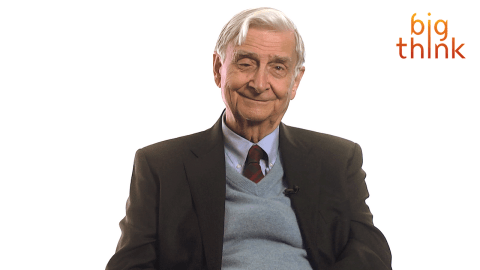Why Did Humans Advance Among Primates? Look to Ants For the Answer.

In many of Edward O. Wilson’s books, most notably his recent titles The Meaning of Human Existenceand The Social Conquest of Earth, the famed biologist adopts a scientific lens to examine the quandaries of the human condition and other opaque areas of human knowledge. These are topics most typically explored by philosophers and sociologists, but Wilson approaches them with the scientific mind. For example, in the Big Think interview below, Wilson asks how Homo sapiens managed to separate from other primates and dominate the large animals of the world. Is this something science on its own can explain?
Sure, says Wilson. The key is called eusociality, and the best way to explain eusociality is to grab a magnifying glass and go looking for ants:
Wilson is one of the world’s foremost experts on eusociality, a byproduct of him being the world’s foremost expert on ants and ant society. Here’s how he described eusociality in a 2005 paper:
“In eusociality, an evolutionarily advanced level of colonial existence, adult colonial members belong to two or more overlapping generations, care cooperatively for the young, and are divided into reproductive and nonreproductive (or at least less-reproductive) castes. The phenomenon is well marked and nearly confined to insects, especially ants, bees, wasps, and termites, where it has been subject to a large body of mostly specialized research scattered across disciplines from genetics to paleontology.”
So in basic terms, eusociality is where evolutionary biology and sociology converge. Take the example of ants. Individual ants owe their survival to the colony’s rigid social structure. Queens and reproductive males are put in charge of replenishing the colony’s living capital. Various castes of worker ants fulfill necessary roles for maintaining the whole. As Wilson explains, this sort of high-level social organization is found in only 20 species of animals. What’s important is that eusociality has allowed ants and termites to dominate the insect world much like humans reign over big animals. What Wilson argues, therefore, is that human beings exhibit qualities of eusociality as well, and could be classified as eusocial beings.
But what do ants, termites, and humans all have in common that allowed for them to become eusocial? Wilson explains it like this: Pretty much every animal species is genetically inclined to reproduce, rear the offspring, and then at some point the offspring is compelled to disperse. Ants, termites, wasps, and naked mole rats each possess what’s called a knockout of a gene that removes the tendency to disperse. It’s like each of those species has a little genetic Al Green inside them forever singing “Let’s Stay Together.”
And according to Wilson, humans are the same way. Our genetic refusal to disperse allows us to eventually become eusocial. This, in turn, elevated us above other primates to a level of dominance among large animals. You and me and Edward O. Wilson aren’t so different from ants, and that’s a good thing.





